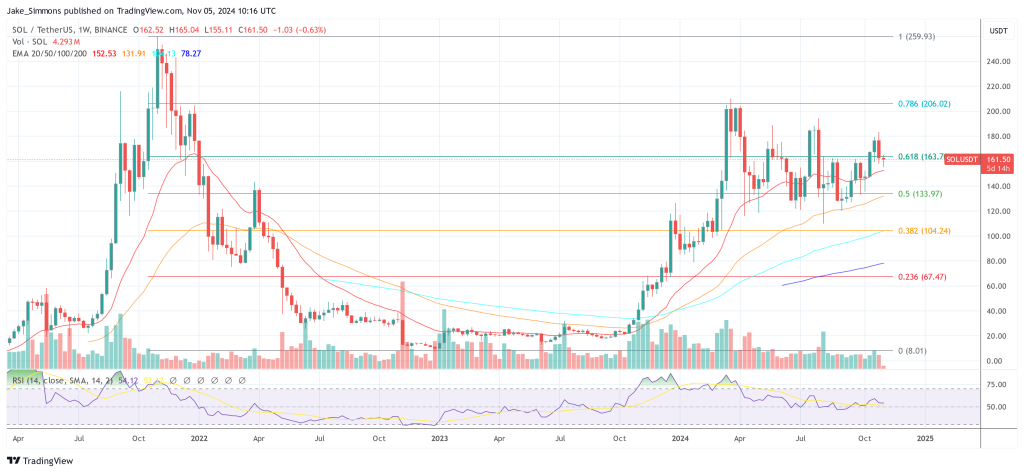VanEck’s proposed spot Solana (SOL) exchange-traded fund (ETF) is facing scrutiny due to concerns over wash trading and the nature of on-chain activity. Matthew Sigel, Head of Digital Assets Research at VanEck, published an in-depth analysis on Tuesday, comparing SOL’s metrics with those of Ethereum to provide context and clarity.
Solana has been recognized for its high throughput and low transaction costs, attracting a significant number of users and developers. With approximately 111 million monthly active wallets, it vastly surpasses Ethereum’s 5.4 million. However, skeptics argue that a large portion of these wallets may be Sybil accounts—fake identities created to manipulate metrics.
Does Solana Have A Wash Trading Problem?
In his analysis, Sigel acknowledges the challenge in distinguishing between organic user activity and that stemming from single users controlling multiple wallets. “We do agree that a very large portion of these wallets are not organic,” he states.
The analysis reveals that memecoin and non-fungible token (NFT) activities constitute a significant portion of Solana’s revenue. Approximately 34.3% of Solana’s revenues are derived from these sources, compared to 6.6% for Ethereum in the current year and 20.3% for Ethereum during its peak memecoin activity between July and October 2021.
When assessing wash trading—a practice where traders buy and sell the same asset to artificially inflate volumes—Solana’s figures are notably higher. An estimated 41.4% of memecoin and NFT volume on Solana is attributed to wash trading. In contrast, Ethereum’s wash trading for these assets stands at 28.9% in 2024 and was 44.4% during its 2021 peak.
“Putting it together, we assess that 14.2% of Solana revenues come directly from wash trading compared to 2% for Ethereum in 2024 and 9% in mid-2021,” Sigel notes. He adds a crucial caveat: the analysis assumes that memecoin wash trading generates miner extractable value (MEV) in line with normal trading. Without MEV on these trades, the estimates would fall by 50%.
To conduct this analysis, the study utilized Dune Analytics queries of both Solana and Ethereum blockchains to accumulate memecoin and NFT activity over specified periods. MEV and transaction fee data were sourced from Artemis, Jito, and Flashbots to evaluate each chain’s gas fee revenue and MEV. For wash trading identification, the analysis employed a threshold ratio of daily trading volume to a coin’s market capitalization.
Several reasons are cited by Sigel for the elevated levels of memecoin trading and wash trading on Solana. First, SOL’s transaction fees are approximately 1/10,000th of Ethereum’s, reducing the opportunity cost of wash trading. Second, the architecture offers a superior user experience for memecoin trading due to its high throughput and low latency.
Third, platforms like Pump.fun simplify memecoin trading, encouraging higher activity levels. Fourth, the approach to MEV may inadvertently inflate trading volumes. “Solana’s MEV trading is driven by statistics-driven assessments of landing a transaction through submitting many orders for the same trade. Some of these likely land without capturing MEV, and this may juice trading figures higher than on Ethereum,” Sigel explained.
What Does That Mean For A Spot SOL ETF?
Sigel draws crucial comparisons between SOL and established companies like Alibaba, DraftKings, and CME Group to provide perspective on speculative trading activities. In Alibaba’s case, there was initial skepticism about package volumes that may have included ’empty packages’ to boost metrics prior to its 2014 IPO. DraftKings and CME Group derive substantial revenue from speculative trading, often providing incentives like reduced fees or rebates to stimulate activity.
By contrast, Solana does not incentivize users in the same manner. Its high activity levels are attributed to its low-cost, high-throughput design. “Solana’s on-chain activity is concentrated mainly in memecoins, making it a hub for speculative assets in the crypto world,” Sigel notes. However, he emphasizes that Solana has the potential to expand beyond speculation into impactful use cases such as decentralized physical infrastructure networks (DePIN) and social media applications.
While memecoins significantly contribute to the current revenue, its valuation—approximately 250 times forward revenue—reflects investor expectations for future growth in non-speculative applications.
Notably, the analysis has direct implications for VanEck’s proposed spot SOL ETF in the United States. The US Securities and Exchange Commission (SEC) has “identified possible sources of fraud and manipulation in the SOL market generally, including, among others, wash trading.”
Given that a substantial portion of revenues may be derived from suspicious trading activities, VanEck has included significant risk disclosures in its prospectus. “The analysis of Solana’s revenue sources is important because it brings to light concerns about our proposed SOL ETP,” Sigel states. “Since there is reason to believe a significant portion of SOL’s revenues are derived from suspicious trading, our ETF prospectus includes significant risk disclosures.”
However, Sigel also expressed optimism about SOL’s future: “We believe this high amount of activity derives from Solana’s high-quality user experience and will become a less important part of Solana’s revenue base as new activity comes to Solana. Ethereum’s transformation should be a guiding light for how Solana’s DEX volumes can mature over time to trading fewer meme-related assets.”
At press time, SOL traded at $161.
















